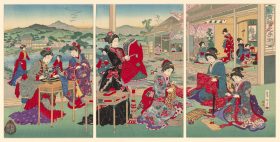Ocean Series by Peter Kovacsy, a NAVA featured artists
For 30 new years’ worth of art resolutions have a look at this. Having gazed into the crystal ball, the National Association for the Visual Arts (NAVA) as the peak body representing the interests of one of the most significant areas of the arts, has decided it’s time to change the future. Watching government arts and cultural policies come and go, NAVA has decided to take matters into its own hands. It has used the occasion of its 30th Anniversary to launch its own National Visual Arts Agenda.
While at first glance the goals may look wishful, on closer scrutiny they prove to be very practical and achievable, having come out of NAVA’s many years of first hand experience both at the coalface of the industry and in productive dealings with key decision makers. Ostensibly the Agenda looks forward 30 years, but with some political will, what is proposed could be quite quickly achieved in the very near future. Of most value is its breadth and cohesion. It addresses all the major contributory factors which should be considered together. This includes engagement by those in the political space nationally and internationally, funding bodies, art education, the media, the private sector and the interested community. NAVA believes the realization of its plan could transform Australia into one of the great art nations.
Already, the level of arts engagement by Australians is substantial but curiously unrecognised. Surveys show that one in five Australians is actively engaged in art and craft making and half our population attends an art gallery every year. That’s more than go to the footy! There’s no lack of love by the public, but governments have not followed suite. NAVA is calling on all three levels of government to double their arts budgets. Currently it is shaming to find that Australia only provides half the funding as a % of GDP compared with our near neighbor New Zealand. With this commitment, the proposals in NAVA’s Agenda could be fully realized.
International engagement and opportunities arising from changes in technology are two areas where NAVA calls for new investment. It has endorsed the value of reinstating the International Cultural Council, though asserts it should operate at arm’s length from government. For other countries to get to understand and appreciate Australian culture and its expression, NAVA affirms that the Council should again bring overseas art curators, writers and critics here to meet Australian artists and see their work. In addition, all Australian embassies should have cultural attachés to engage in cultural diplomacy, not just to foster trade but to secure engagement with Australian art and artists and to build international exchange relationships, especially in our region.
In relation to newer technologies, NAVA has drawn attention to the need for opportunities to be developed for Australian artists & designers to play a greater role within the creative industries and beyond, including all aspects of design and design thinking, gaming, robotics, 3D printing, the audio-visual industries including animation, website design and online visual communication and new areas of technology that we don’t even know about yet.
But there are also other ways of investing. NAVA has proposed that in every major new development, artists should be provided with free or very low cost work & presentation space through a ‘Percent for Art Space’ social responsibility levy on developers, to provide healthy, safe space for artists and make art readily accessible to communities locally. As the American academic Richard Florida has demonstrated, successful cities are those where there is a strong vibrant cultural life which draws investment and positioning by the business sector. It’s where people want to be.
As the essential bedrock, NAVA addresses the area of education and training. While the mandatory inclusion of arts in the national curriculum looks likely, cuts to arts funding in TAFEs and the gradual erosion of a diversity of training offerings in university art schools is compromising the viability of a career in the arts by narrowing the scope of what is available and rendering it unaffordable. NAVA points out that the kind of skills developed by young people in art school is what is increasingly valued across the board: in the public sector; in business; and in industry. Companies are becoming more interested in the qualities of entrepreneurism, innovation, agility and adaptability, resourcefulness and lateral thinking than in specific narrowly focused vocational skills. And this is what arts people are trained to do. Education funding not only needs to be reinstated but expanded as an investment in Australia’s economic future beyond the mining boom.
These propositions are just a part of NAVA’s larger National Visual Arts Agenda.
Around the world, communication is increasingly visual. With our addiction to technology, Australia could play a lead role if our visual and media arts, craft and design were given a boost. If all the components of NAVA’s National Visual Arts Agenda were to be developed in tandem, then Australians would benefit from enriching experiences, a more innovative economy sustainable over the long term and social wellbeing outcomes for all the diverse sectors in the community. It could transform our way of perceiving the world and our sense of who we are, both as individuals and as a nation.





